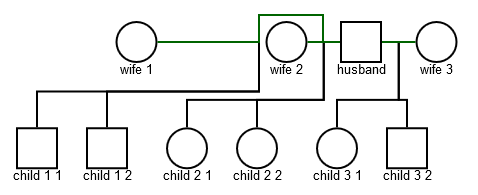Hi,
I’m currently reviewing your library for developing a genogram.
I’ve noticed an issue when a family member has been married more than twice. See below. (The structure of the data is slightly different, but I can replicate this issue on the genogram example on your website)
Male 1 has been married twice
var familyData = [
{ key: 1, n: "Male 1", gender: "M", marriages: [{ marID: 1000, spouseID: 2 }, { marID: 1000, spouseID: 3 }] },
{ key: 2, n: "Female 1", gender: "F", marriages: [{ marID: 1000, spouseID: 1 }] },
{ key: 3, n: "Female 3", gender: "F", marriages: [{ marID: 11111, spouseID: 1 }] },
{ key: 300, n: "Test", gender: "M", marriages: []}
];
As you can see, this renders as expected.
Male 1 has been married 3 times
var familyData = [
{ key: 1, n: "Male 1", gender: "M", marriages: [{ marID: 1000, spouseID: 2 }, { marID: 11111, spouseID: 3 }, { marID: 222222, spouseID: 4 }] },
{ key: 2, n: "Female 1", gender: "F", marriages: [{ marID: 1000, spouseID: 1 }] },
{ key: 3, n: "Female 3", gender: "F", marriages: [{ marID: 11111, spouseID: 1 }] },
{ key: 4, n: "Female 4", gender: "F", marriages: [{ marID: 222222, spouseID: 1 }] }
];
I’ve spread the nodes out just to show you how it renders. But you can see that Male 1 no longer appears, and the links are broken.
If you could give me some pointers on resolving this that would be great, as it seems gojs is the most flexible solution in regards to integrating the dataset I have to work with.
Thanks
Rob

